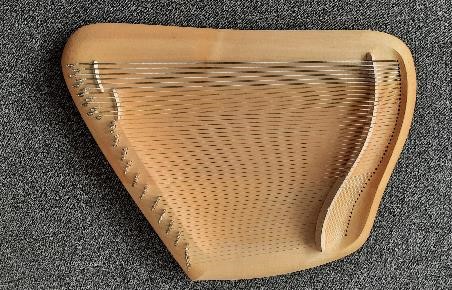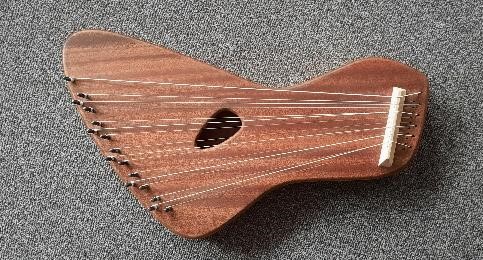Music therapy in pregnancy
Viola Heda
Last update: 06.05.2022
Anthroposophical music therapy for pregnant women is a sub-section of anthroposophical artistic therapies and is undertaken on an inpatient and outpatient basis. In anthroposophy, the human being is perceived as a physical, soul and spiritual being. The musical elements are selected in this therapy according to holistic aspects based on such an understanding of the human being. According to Rudolf Steiner, the human being experiences the resonance of the spiritual world in music (1); thus music can be described as a link between cosmos and earth.
Music therapy takes place primarily at the beginning or towards the end of a pregnancy, as complications such as hyperemesis gravidarum, bleeding, cervical incompetence or premature labour occur more frequently during these periods.
In the music therapy setting, pregnant women are supported with different methods. Listening to music allows the expectant mother to enter into a state of attentiveness and stillness. Through the concrete experience of the music, both life processes are stimulated and the sense of connectedness and wellbeing with her own body is improved. The active creative making of music is also an important part of the therapy.
The start of pregnancy
At the beginning of pregnancy, women find themselves in a life situation in which comprehensive changes occur. The hormones change so that the body can adapt to the new tasks, but they also cause mental unrest. For many expectant mothers, the external situation in which they live needs to be adapted and rearranged. In such a sensitive phase, hospitalisation can be an additional burden. Here the expectant mothers need an envelope, security, safety, trust and above all the feeling of being understood.
Hyperemesis gravidarum, sickness in pregnancy with vomiting, is a common symptom at the beginning, as is the sudden onset of bleeding. As a result, the pregnant woman's fear of losing her child grows, she feels unwell and insecure. For many, this is a state of stress and/or exhaustion that lasts several weeks.
Here music therapy can accompany the expectant mother physically, emotionally and spiritually. Physical relaxation, mental relief and spiritual nourishment through music and conversation can help women cope with this situation. Here patients describe music as a way out of their unsettled thoughts. Others describe sound as something that brings them back to themselves and gives them confidence to follow the new path with courage, even if the transformation process seems difficult at the beginning.
The end of pregnancy
Towards the end of pregnancy, risks arise, for example, of an early birth due to premature labour, cervical incompetence or metabolic disorders. Thus women often find themselves in the situation of having to lie in bed for weeks in order to prevent a possible premature birth of their child. Many women find this hard. Here again the expectant mother is burdened by worries and fears. Every day can be experienced as an obstacle. Sometimes women even lose the feeling of being connected with their developing child.
Here the goals of music therapy are the physical and mental relaxation of the expectant mother, improving her own perception of her body, and strengthening the bond between mother and child. Recent research has shown that the foetus can perceive sounds and noises from the outside world as early as the sixteenth week of pregnancy (2). The positive effect of music on the unborn child can be determined by cardiotocography or foetal monitoring – so-called CTG measurements.
Mothers often report that they experience a reaction in their child to pleasant external stimuli such as music, the mother's or father's voice. Other patients report that the music offers them an envelope, that they feel very connected to their child during the music or that their physical sense of wellbeing increases.
In the following, the different approaches of music therapy are described in more concrete terms.
Receptive music therapy
An important part of music therapy in gynaecology is receptive therapy. That is to say that the patient is not active herself but outwardly passive as she listens to the music. The focus is placed entirely on the listening process. Calmness, stillness and undivided attention can arise. Once the anxious brooding has quietened due to attentive listening, tension and discomfort gradually ease. The patient can feel freer again and experience the great sanctum in her body.
Another possibility is the journey of the imagination with sounds. The strong ties to the body are loosened by the sound so that pictorial experience in soul and spirit becomes possible again more easily. Inner spaces are created which enable the patient to cope better with everyday life.
For pregnant women, receptive anthroposophical music therapy prefers to use instruments that have a soft flowing sound and are assigned to the so-called rhythmical system, such as the lyre. This instrument harmonises cardiovascular processes and regulates the breathing.

Fig. 1: Tenor lyre © Viola Heda
Goals of receptive music therapy are:
- Relaxation
- Calmness and serenity
- Being able to listen attentively
- Release from brooding thoughts
- Trust
Resonance therapy
Resonance therapy plays an important role at the end of pregnancy. It is a technique of music therapy in which the patients can hear the music on the one hand while also feeling its vibration at the same time.
There have been positive experiences in anthroposophical music therapy in this regard with monochords, Tao lyres or Bordun lyres. The instruments are placed on different parts of the body, played in a calm flowing rhythm and supported with the voice as needed.
Since women in pregnancy have a significantly increased amount of blood flowing through their bodies, and they have to deal with hormonal changes and weight gain, long periods of lying down often have a negative effect on metabolic processes. The vibrations, which are transmitted directly to the body, can stimulate metabolic processes and provide a positive body feeling.

Fig. 2: Tao lyre © Viola Heda
Goals of resonance therapy are:
- Release of physical and mental tension
- Antispasmodic and muscle relaxing effect
- Stimulation of the vegetative metabolic processes
- Regulation of the respiratory process
- Improving body awareness
Active music therapy
In active music therapy, the patient herself plays. In this way the expectant mother can be creatively active herself and enter into musical contact with herself and her child. Through being creative themselves as they make music, mothers can be made aware of the special situation in which they find themselves in their lives in which creative spiritual forces are also at work, creating new life. In this way women can be encouraged to refocus on the essentials, find trust, and distance themselves from their fears and worries. Similarly the creative activity can shift the focus away from worrying towards confident thoughts and feelings.
Small, easy-to-play instruments should be chosen that can be played together to create a harmonious sound. The Sansula or Bordun lyre, for example, are suitable for this. The pentatonic children's harp or the fairy lyre are suitable for playing to the still unborn child. This can then also be continued when the child is born.
See also the article "Singing and Music for Babies and Toddlers“ at https://www.anthromedics.org/PRA-0905-EN.

Fig. 3: Bordun lyre © Viola Heda
Goals of active music therapy are:
- Release from worrying thoughts and feelings
- Strengthening bonding
- Creating trust and confidence in this life situation
- Stimulating self-efficacy and creative processes
Bibliography
- Steiner R. Das Hereinwirken geistiger Wesenheiten in den Menschen. GA 102. 4th edition. Dornach: Rudolf Steiner Verlag; 2001, p. 223. English translation: Steiner R. Good and Evil Spirits and their Influence on Humanity. CW 102. Forest Row: Rudolf Steiner Press; 2014, lecture 13.
- López-Teijón M, García-Faura Á, Prats-Galino A. Fetal facial expression in response to intravaginal music emission. Ultrasound 2015;23(4):216-223. DOI: https://doi.org/10.1177/1742271X15609367.[Crossref]